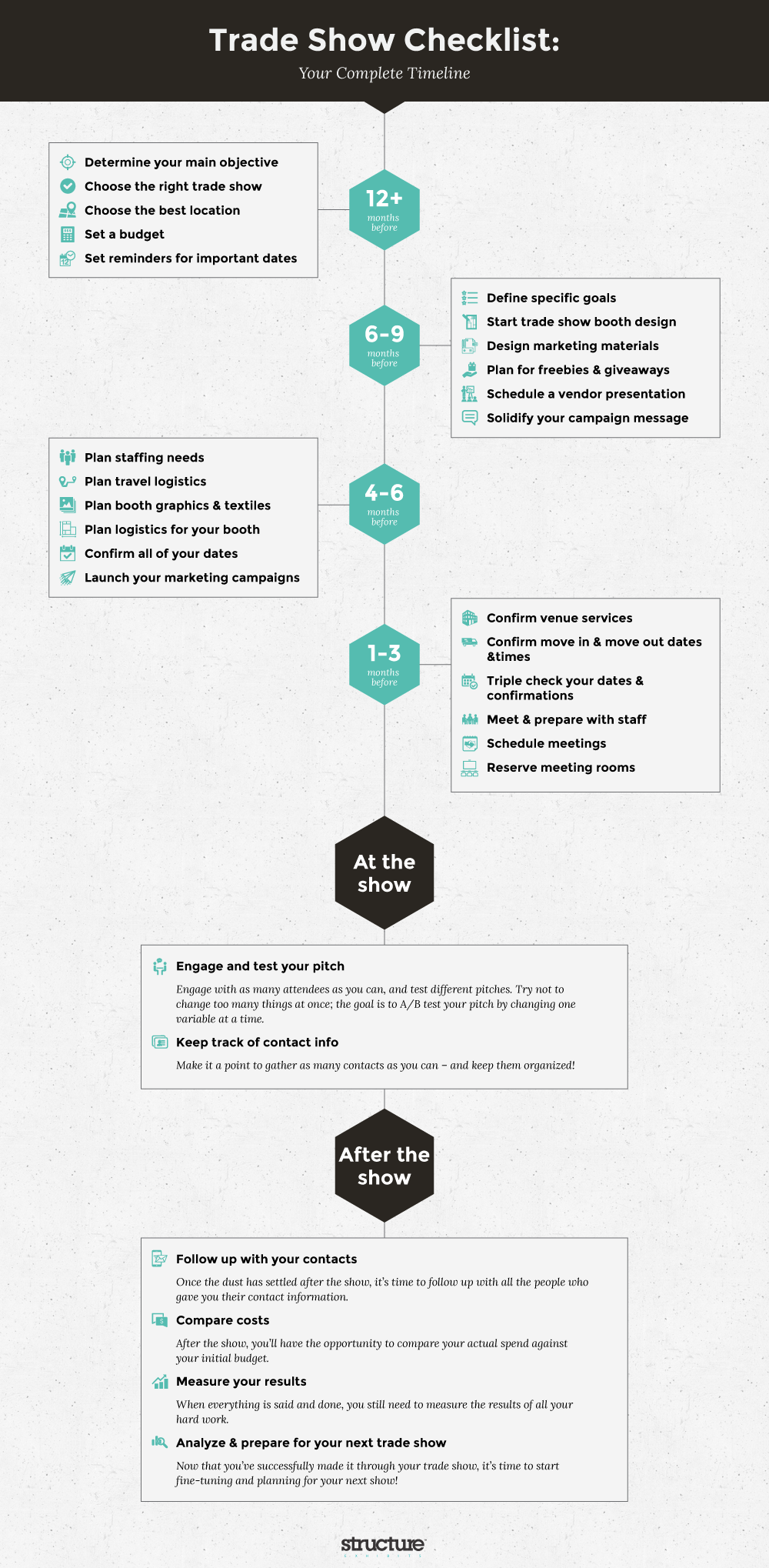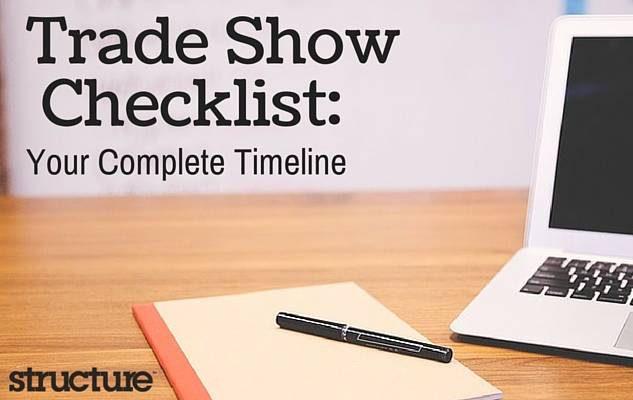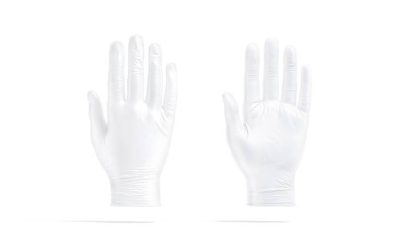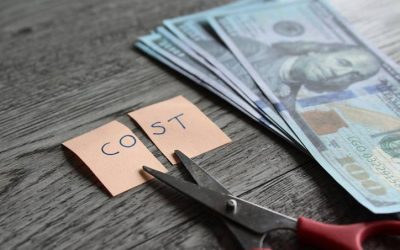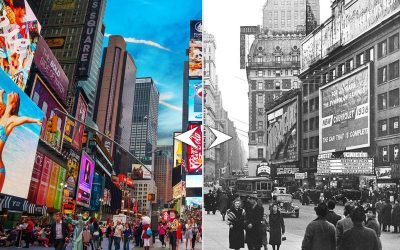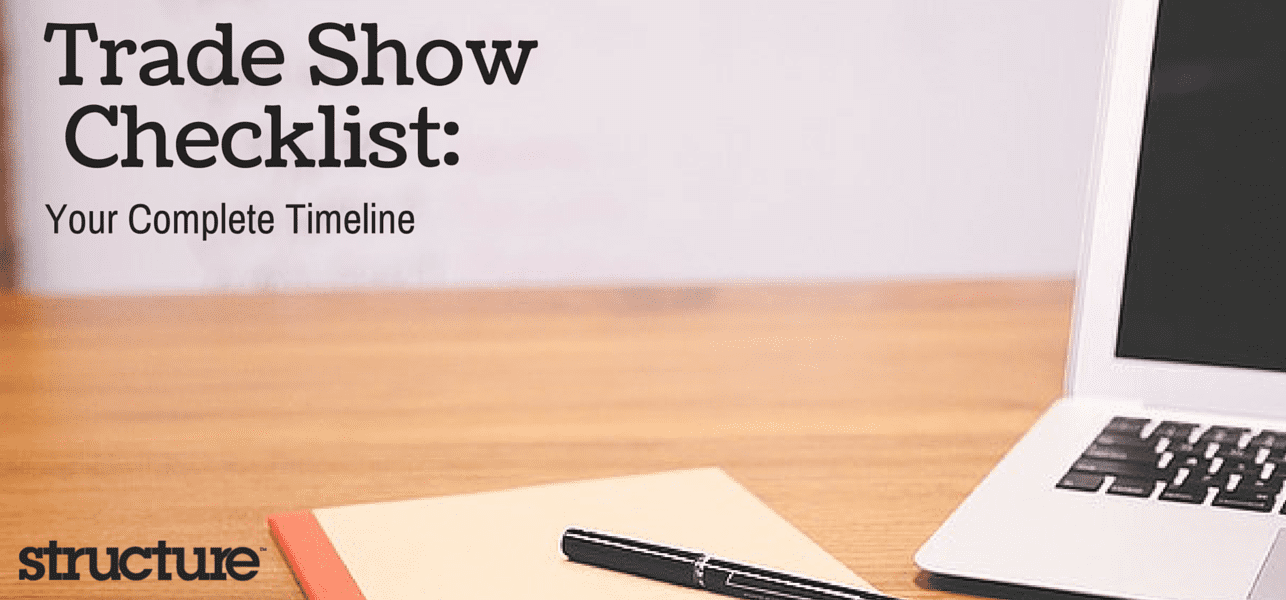
Whether you’re a startup or enterprise, attending a trade show is a great way to increase exposure and growth for your business. However, like most business endeavors, it takes planning and commitment to make your trade show a success. This trade show checklist & timeline will help you stay on track so you can get the most out of your show. You can also check out this helpful infographic:
12+ Months Before Your Trade Show
Determine your main objective for the show
There are countless benefits of attending a trade show; increased brand awareness, meeting new leads, meeting investors, etc. While you may benefit from several of these, you’ll be most successful if you focus on one main objective, and craft your display around that.
Choose the right trade show
Once you’ve narrowed down your purpose for attending a trade show, you can start researching which specific trade show best fits your needs.
Choose the best location for your booth
Now that you have a clear objective and a trade show picked out, you should start reviewing the floor plan for your trade show venue and decide where you’d like to set up your booth. For example, if you want to interact with as many people as possible, it may be better to pick a location near the bathrooms or food areas. Keep in mind that many shows booth selection process is based on seniority, so it is always good to have 6 or 7 options, in order by best choice first, prepared which will make the ordering process easier and the selection will include a tactful approach. Make sure to check for any discrepancies in the floor plans as many clients have shown up to exhibit spaces only to find out there is a huge pillar right in the middle of the space. Realize that different types of exhibit spaces have different rules. As for instance, peninsula exhibits (and exhibit space directly behind another which does not have an aisle in-between) has far more regulations, i.e. height limitations, hanging signage locations, than a traditional island space. Inline spaces also have strict regulations, including line of sight for your neighbors and often hold an 8ft. height limit.
Set a budget
Set yourself a realistic budget for the complete trade show process. Don’t forget to include pre-show preparations, post-show services like booth dismantling shipping, and any advertising or marketing efforts that will coincide with your trade show appearance.
Separate your budget into categories. Exhibit Purchase, Exhibit Labor, Show Services, Shipping, Pre-show mailing, giveaways, etc. When requesting exhibit design provide the budget for that particular aspect. This will save you lots of time & money. Designing an exhibit takes a lot of time to create. Without a budget the design team has no parameter to start from and the design can end up far outside of the budget which could mean starting over.
Set reminders for important deadlines
Things are going to move quickly as your trade show date nears, so take the time to set reminders now about important deadlines for payments, deposits, registration, and any other details that might get overlooked.
6-9 Months Before Your Trade Show
Define specific goals
Recall your main objective for attending your trade show and set specific goals that will help you achieve your bigger objective. For example, if your main objective is to grow your customer base, you could set a goal to get contact information from a specific number of potential leads. Similarly, you can set specific goals for things like number of meetings booked, number of potential investor names collected, number of registrations for your ads or email subscriptions, and so forth.
Start trade show booth design
If you haven’t already done so, now is the time to contact a trade show designer to help you determine the specific details of your trade show display or booth. Most exhibit houses offer in-house design capabilities and will often package the design into the purchase or rental of your exhibit. If you already own your own booth assets, you’ll need to determine which components you will be using at your trade show. If you’re creating a new booth or renting an exhibit, you should start the design process now. If you’re unsure where to start, a qualified trade show exhibit design company can help walk you through the process.
Design marketing materials
Engaging with people on the trade show floor is a great way to promote yourself, but you need to spread the word about your booth (and the show itself) long before the show starts. Six to nine months before the show is the ideal time to start designing any external promotional items like email marketing flyers, direct mailers, and billboards. It’s also a good time to start planning sponsorship opportunities.
Plan for freebies & giveaways
Now is the time to start planning on giving away any “swag” – flyers, handouts, pens, keepsakes, etc. These items can often take quite a bit of time to produce and coordinate from a logistics standpoint, so don’t put this off.
Schedule a vendor presentation
While it’s not mandatory to do a vendor presentation, it’s a good idea if you’re serious about reaching an audience. Vendor presentations provide you with a platform to talk in depth about your brand or product. You’ll be lucky to get a minute or so on the trade show floor, so take advantage of this opportunity!
Solidify your campaign message
Like your overall trade show objective, your presentation will be much more effective if you narrow down a specific theme or message to promote during the show. Think about what you really want your audience to know about you, and craft your message around that.
4-6 Months Before Your Trade Show
Plan staffing needs
By now you should have some idea of how big your operation is, and what kind of budget you are working with. About four to six months before the show, you should begin to plan your staffing needs accordingly.
Plan travel logistics
With your show and venue secure, you can begin to plan for logistics and travel. Start booking any flights, hotel rooms, and any other transportation methods you’ll require to get to and from the show.
Plan booth graphics & textiles
The overall components of your trade show booth should be clear by now, so it’s time to start planning the more superficial components like graphics and textiles.
Plan logistics for your booth
Once you’ve finalized your trade show booth designs, you need to plan on how you’re going to get it to and from the trade show. Keep in mind that delivery is separate from drayage and both are separate from assembly/disassembly.
Confirm all of your dates
Now is the time to double check and confirm all of your delivery dates, arrival/departure dates, and deadlines. This includes dates from your trade show booth designer, your hotel, your airline company, the trade show venue, your manufacturer or supplier, and your marketing team.
Launch your marketing campaigns
You should launch your marketing material about 4 months before the trade show. This includes email campaigns, direct mailer cards, and any other marketing initiatives you’ve taken on.
1-3 Months Before Your Trade Show
Confirm venue services
Will your booth require an internet connection? Do you have specific electrical requirements? Does your space include cleaning services? It’s a good idea to double check these details now, so that you have time to make other arrangements if need be.
Confirm move in & move out dates & times
A few months before the show, you should double check your delivery and move in dates with both your vendor and booth designer. It’s important to note that your venue may have delivery deadlines prior to the show, so make sure to get this information to avoid unexpected fines.
Triple check your dates & confirmations
It’s well worth going over your delivery and arrival dates one final time before things get crazy. On occasion show management may modify these dates in order to accommodate changes in their original forecasts.
Meet & prepare with staff
Make sure everyone on your team knows the game plan, and knows what they will be doing before, during, and after the show. If you are doing any demonstrations or shows, make sure you run through these well before you go live. Make sure that your AV supplier has copies of the content so they may test it on all the devices being used for the show to ensure compatibility.
Schedule meetings
Start scheduling meetings with press, vendors, and any other opportunities to spread the word about your display.
Reserve meeting rooms
While you’re not required to reserve additional meeting rooms, it might be a good idea to invite potential leads or investors to a more personal setting for food or drinks after the show. Providing them with this incentive gives you an opportunity to talk to these individuals at a more in depth level.
At the Show
Engage and test your pitch
Engage with as many attendees as you can, and test different pitches. Try not to change too many things at once; the goal is to A/B test your pitch by changing one variable at a time.
Keep track of contact info
Make it a point to gather as many contacts as you can – and keep them organized! If someone hands you their business card, write notes on the card about your conversation with them, or attach post-its to the card before storing it. These notes will become extremely valuable when you follow up with them later.
After the Show
Follow up with your contacts
Once the dust has settled after the show, it’s time to follow up with all the people who gave you their contact information. Refer back to the notes you took during the show to personalize your next conversation with them.
Compare costs
After the show, you’ll have the opportunity to compare your actual spend against your initial budget. You might find that you were over or under your original budget and that’s okay – use this information to reflect on why the numbers turned out the way they did and where you can adjust for next time. It is also good practice to verify all show management and vendor charges, especially labor hours and rates. Many times you will find discrepancies in the billing versus the actuals which can not only save you thousands but also make you the hero.
Measure your results
When everything is said and done, you still need to measure the results of all your hard work. Did you meet your goals? How many leads or registrations did you get? How many people signed up for your newsletter? Did you close deals with any of the leads you met at the show?
Analyze & prepare for your next trade show
Now that you’ve successfully made it through your trade show, it’s time to start fine-tuning and planning for your next show!
Whether you’re a first time trade show presenter or a seasoned veteran, Structure Exhibits can help you create the perfect trade show display. Give us a call at (888) 633-4162 to start building your custom display!
